PS1 and PS2: 'district' planning matters return - guidance notes
Updated 4 March 2022
Applies to England
Useful Information
The purpose of these forms
The PS1 and PS2 forms collect information about the range of district matter applications that local planning authorities handle when exercising their development management functions.
The figures collected are summarised and published as National Statistics in the planning application statistics quarterly statistical release and in a range of associated live tables and interactive dashboards.The statistics are used by central government to monitor planning policies and performance, and by a wide range of other users, including local authorities, academics and the general public.
The forms are included on the Single Data List and so are required to be completed by every local planning authority.
The PS1 form collects summary information about the number of planning and related applications on hand at the beginning of the quarter, received, withdrawn, called in or turned away during the quarter; the number of decisions and delegated decisions; and information on specific types of applications such as applications accompanied by Environmental Statements, Regulation 3 and 4 consents, decisions on applications for prior approval and enforcement action.
The PS2 form collects more details about the decisions made during the quarter, broken down by:
a. Development type
b. Whether permission/consent was granted or refused; and
c. The time taken from application to decision
Who should complete this form?
PS1 and PS2 returns are required for each district planning authority in England, i.e. metropolitan and non-metropolitan districts, unitary authorities, National Park Authorities and Development Corporations.
District planning authorities whose areas include parts of National Parks Authorities or Development Corporations should exclude from these returns information relating to applications made to and handled by the National Park or Development Corporation.
National Park Authorities and Development Corporations should each complete a single return for district matters which should relate to their entire area (and a separate return for county matters where required).
Contacts for help
If you have any problems providing the data required in the return please contact planning.data.collection@levellingup.gov.uk, and a member of the team will get back to you.
If you experience any technical issues with the DELTA system, please contact the DELTA Service Desk (Portal is the preferred option).
To log in to DELTA visit https://delta.communities.gov.uk/login and use the username and password provided to you previously. If you have not received login details, please contact the DELTA Service Desk (Portal is the preferred option).
Revisions
Despite local authorities’ best efforts, it is unlikely that all data submitted is completely accurate, whether through the receipt of subsequent information not available at the submission deadline, errors in calculation, or another reason. As such, our Revisions Policy allows for local authorities to correct errors found, in order to maximise the quality of our published data. The majority of revisions see only minor changes made to data, with little to no impact on published national statistics. These changes will be published at the next scheduled release, with no specific announcement, and the previously released data is not revised.
These revisions can be made for the previous 7 quarters, in line with the time period covered by the department’s designation tables (Live Tables P151 to P155). They can be made through DELTA. If you realise that you need to make a revision, please get in touch with our team (planning.data.collection@levellingup.gov.uk) and we will arrange access to the relevant quarter so you can make the required corrections. You will receive an email, with a link to the data you have previously submitted and requested to revise. Following this link will allow you to amend the data for that quarter and re-submit.
Some revisions are considered major revisions. These might date further back than the previous 7 quarters and include the late submission of a local authority with a notable impact at the national level, substantial errors in the statistical process, or other major methodological issues, whether by local authorities or central government. Major revisions may require a non-scheduled revision of the statistical release to be published, along with a correction notice explaining the error. We aim for transparency in such cases, in order to maximise the perception of quality in all official statistical releases. If you think that you need to make a major revision, please get in touch with our team at the above email address.
The policy on revisions has been developed in accordance with the UK Statistics Authority Code of Practice for Statistics and the department’s revisions policy.
Latest changes to DELTA form
April to June 2022 to April to June 2023 quarters
No changes
January to March 2022 quarter
Within the PS1 Q6 PDR Section, 6b is no longer collected
October to December 2021 quarter
Existing PDR Category 6c ‘Retail and sui generis uses to residential’ has been renamed as ‘Launderette, betting office, pay day loan shop, hot food takeaway, amusement arcade or centre, or casino to residential’.
‘Prior approval not required’ has been removed as an option for PDR categories 6h-n to comply with the legislation. Any such decisions which were made as ‘Prior approval not required’ for questions 6h-6n during the current quarter should instead be included against PDR category 6p All Others along with a mention of this in the comments box.
Within PS1 a new Commercial, Business and Service to residential PDR category has been added to reflect the recent change to legislation (effective from 1 August 2021). This new category has been coded as 6o and is voluntary for completion. This change has also resulted in the PDR category All Others being re-coded as 6p:
(o) Commercial, Business and Service to residential (Class MA of Part 3 of Schedule 2).
(p) All others - refers to all other types of development for which decisions on applications for prior approval had been made during the quarter.
Within the PS2 section of the form there is a new question Q7 to pick up Major Public Service Infrastructure development decisions to reflect the recent change to legislation (effective from 1 August 2021). Any applications made during this quarter should be included at Question 1b of the PS1 form (‘Planning and related applications received during the quarter’). The time taken categories for decisions on any such applications not subject to performance agreement are ‘Not more than 10 weeks’, ‘More than 10 weeks’.
The changes listed above are also discussed within the related sections of this guidance document (in the PS1 section, question 6 on pages 20-22, and the PS2 section on pages 27-30).
July to September 2021 quarter
No changes
April to June 2021 quarter
Within the PS1 Q6 PDR Section, 2 categories 6f & 6g, are no longer collected, and 7 extra categories, 6h to 6n, were introduced to reflect changes to legislation (Part 20 of Schedule 2 to GPDO 2015). These questions are voluntary for completion. If data for these extra PDR categories cannot be provided any related applications should be included within 6o) All Others.
(h) Building upwards householder extensions (Class AA of Part 1 of Schedule 2 to the General Permitted Development Order (GPDO 2015)
(i) Building upwards to create dwellinghouses on detached blocks of flats (Class A of Part 20 of Schedule 2 to GPDO 2015)
(j) Building upwards to create dwellinghouses on detached commercial or mixed-use buildings (Class AA of Part 20 of Schedule 2 to GPDO 2015)
(k) Building upwards to create dwellinghouses on commercial or mixed-use buildings in a terrace (Class AB of Part 20 of Schedule 2 to GPDO 2015)
(l) Building upwards to create dwellinghouses on dwellinghouses in a terrace (Class AC of Part 20 of Schedule 2 to GPDO 2015)
(m) Building upwards to create dwellinghouses on detached dwellinghouses (Class AD of Part 20 of Schedule 2 to GPDO 2015)
(n) Demolition of buildings and construction of dwellinghouses (Class ZA of Part 20 of Schedule 2 to GPDO 2015)
(o) All others - refers to all other types of development for which decisions on applications for prior approval had been made during the quarter
“County matter” (minerals and waste) applications
Applications for county matter developments should not be recorded on the PS1/PS2. Any authority that is responsible for determining county matter applications (broadly minerals and waste applications) should record these applications separately on the CPS1/2 forms.
Where a Regulation 3 or 4 decision relates to ‘county matters’, this should be recorded on the CPS1/2 form and excluded from Question 5 of the PS1 form.
A more detailed definition of county matters is contained in:
(a) Paragraph 1 of Schedule 1 to the Town and Country Planning Act 1990; and
(b) the Town and Country Planning (Prescription of County Matters) (England) Regulations 2003 (SI 2003 /1033)
Completing the returns
Completed forms should be submitted on DELTA by 4 August 2023.
If you will be unable to meet this deadline, please contact the Planning team (planning.data.collection@levellingup.gov.uk) in advance of the deadline. Extensions are only possible when extenuating circumstances apply.
Please complete all boxes on the PS1 and 2 forms as set out in the notes below.
When signing off the return, boxes should not be left blank. If there is no activity to record for the period you should enter a ‘0’ (zero) in the relevant box.
Please ensure that you complete the box at the end to say that the return is final.
As the user completes the return, validation rules (where appropriate) will be displayed.
To log in to DELTA visit https://delta.communities.gov.uk/login and use the username and password provided to you previously. If you have not received login details, please contact the DELTA Service Desk (Portal is the preferred option).
Please note: this process currently functions better when using Google Chrome as your web browser.
Email reminders will be sent periodically to alert data providers that the collection instance to submit data is live.
Once you have signed into DELTA you will arrive at the Welcome Page.
To navigate to the current collection instance for the PS1/2 form manually, please follow the steps set out below:
1. Click on ‘Submissions’ to submit data.
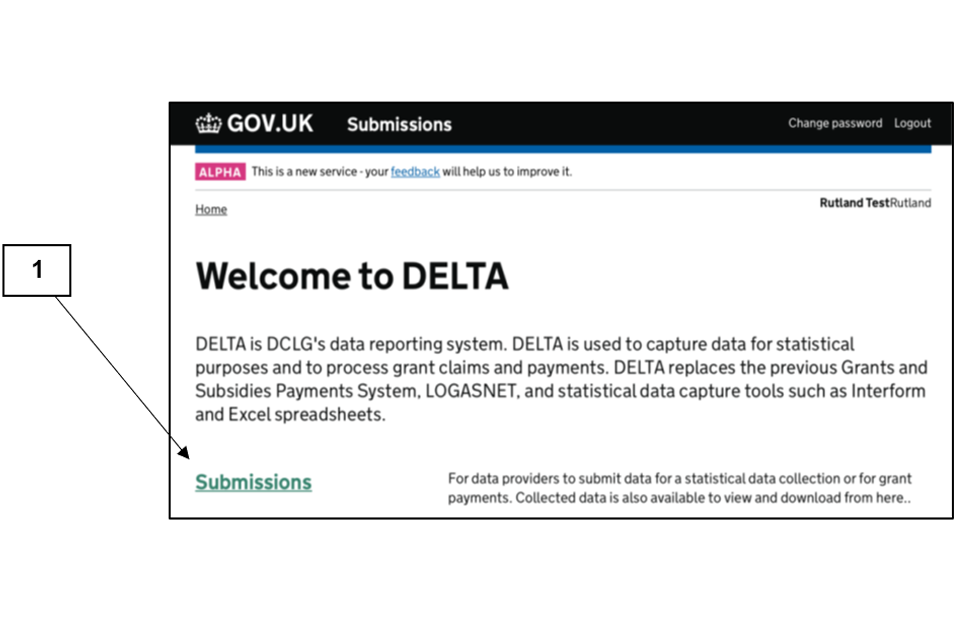
submissions screenshot
2. Click on ‘Collection Requests’.

collection requests screenshot
3. Navigate to the correct instance of the form you are submitting data for – multiple instances of the form exist, covering each quarter.
You will have received a notification with the exact name of the form awaiting completion and can use this as your reference. You can also sort by the most recently added form or search using the search field. If you are unsure, please contact planning.data.collection@levellingup.gov.uk.
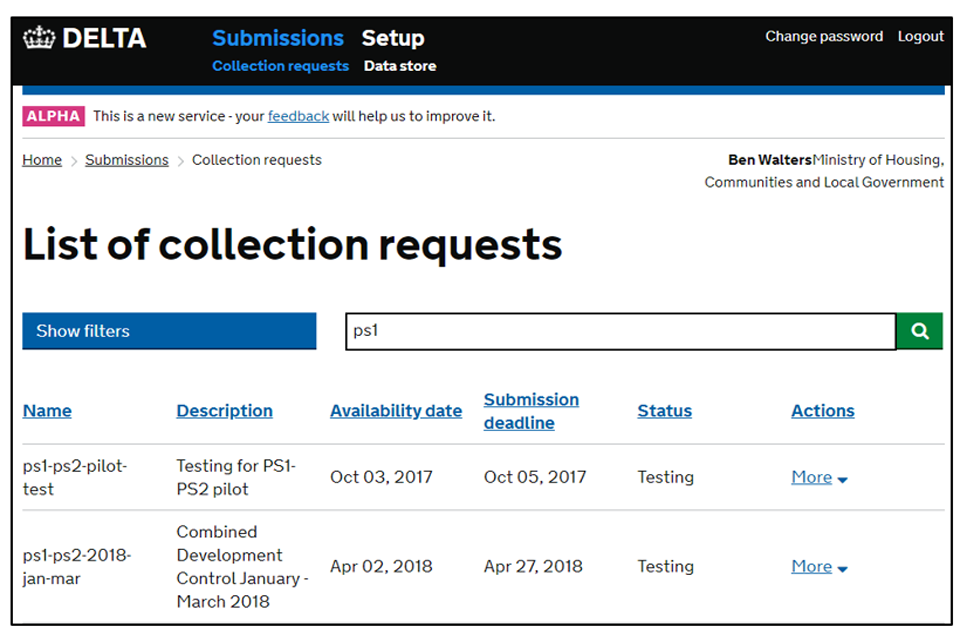
3 list of collection requests screenshot
4a. Once you have navigated to the correct form, under Actions select the drop-down menu ‘More’ for the instance on which you wish to submit data.
4b. Select ‘Provide Data’.
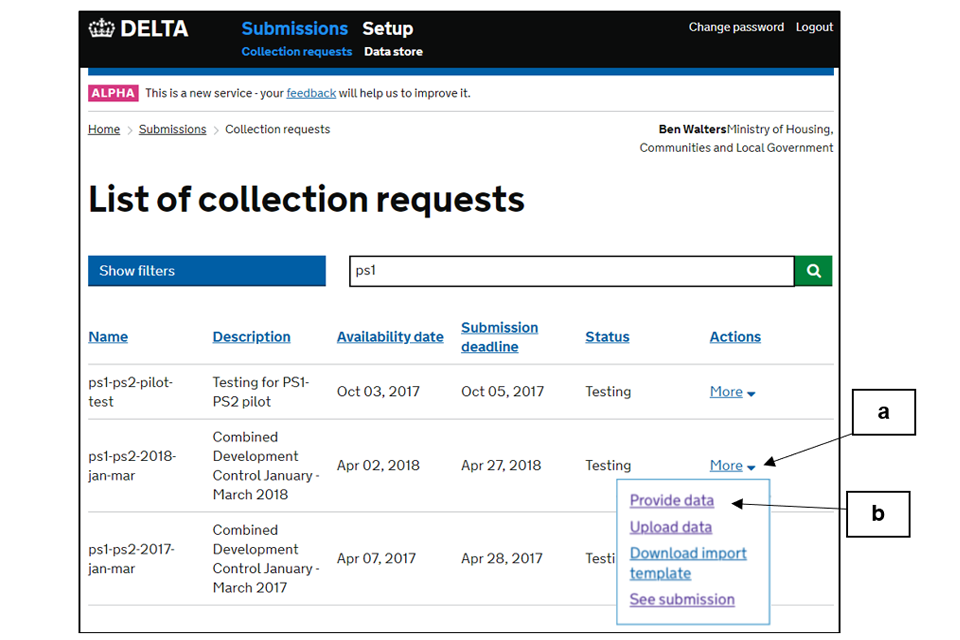
4 list of collection requests screenshot
Note: In the example above, the selected form would refer to the PS1/PS2 form covering the January to March quarter of 2018, with collection between 2 April and 27 April.
Warning
Please note that after logging in and navigating to the correct form to submit your data, the system will automatically log you out after 15 minutes of inactivity.
We recommend that you regularly save your submission to ensure that no data is lost.
Instructions on how to save, print and submit for are included below for each form.
PS1
Questions 1 and 2
The following applications should be included under Questions 1 and 2:
(a) Valid applications for planning permission for development under Articles 5,6 and 7 of the Town and Country Planning (Development Management Procedure) (England) Order 2015 (SI 2015/595) (as amended) namely:
(i) Applications for outline planning permission
(ii) Applications for approval of reserved matters
(iii) Applications for full planning permission
This should include any application for time limited permission and any application that is accompanied by an environmental statement.
(b) Applications under section 73 of the Town and Country Planning Act 1990 to vary or remove conditions (including applications for minor material amendments) except applications for prior approval made under section 73, which are to be reported at question 6.
(c) Developments which would normally have been permitted under the Town and Country Planning (General Permitted Development) (England) Order 2015 as amended, but have come before the local planning authority for determination because they require an Environmental Impact Assessment.
(d) Valid applications for listed building consent under section 8 of the Planning (Listed Buildings and Conservation Areas) Act 1990.
(e) Valid applications for planning permission for relevant demolition of an unlisted building in a conservation area under section 70 of the Town and Country Planning Act 1990.
(f) Valid applications for consent to display advertisements under the Town and Country Planning (Control of Advertisements) (England) Regulations 2007 (SI 2007/783) (as amended).
(g) Valid applications under regulations 3 and 4 of the Town and Country Planning General Regulations 1992 (SI 1992/1492) (as amended).
(h) Retrospective applications under section 73A of the Town and Country Planning Act 1990
The following should be excluded from Questions 1 and 2:
(a) Non-material amendments under section 96A of the Town and Country Planning Act 1990.
(b) Applications for the discharge of conditions under Article 27 of the Town and Country Planning (Development Management Procedure) (England) Order 2015 (as amended). These are also known as applications for the approval of any matter required by a condition on a previous planning permission.
(c) Tree Preservation Orders made or confirmed, applications to carry out works under a Tree Preservation Order, notices for works to trees in a conservation area (‘section 211 notices’); decisions on high hedges complaints under Part 8 of the Anti-social Behaviour Act 2003; applications for felling licences; hedgerow removal notices under the Hedgerow Regulations 1997; notices under section 215 of the Town and Country Planning Act 1990 which relate to enforcement action to require land or property to be cleared up where its condition adversely affects the amenity of the area.
(d) Applications, determinations and approvals for the erection or significant alteration etc. of agricultural and forestry buildings in National Parks.
(e) Applications, determinations and approvals under Schedule 2 to the Town and Country Planning (General Permitted Development) (England) Order 2015 as amended. These are recorded only in Question 6 and are not part of the total decisions recorded at Question 2 for which more detail is provided in the PS2.
(f) Applications for Hazardous Substances Consents under the Planning (Hazardous Substances) Regulations 2015.
(g) Notifications under Circular 14/90 (electricity generating stations and overhead lines). These are recorded only in Question 7a.
Notifications were previously included under Questions 1 and 2 ,but have been excluded with effect from 1 April 2014 following the transfer of the separate question on notifications from PS2 to PS1 (Question 7).
(h) Applications for certificates of lawful development. This includes: i) existing uses and developments (under section 191 of the Town and Country Planning Act 1990), and ii) proposed uses and developments (under section192 of the Town and Country Planning Act 1990). These are recorded only in Question 7b.
(i) Applications for certificates of appropriate alternative development. Certificates of appropriate alternative development are an aid to valuation when land is taken by compulsory purchase. They state what planning permissions might have been granted if the scheme underlying the compulsory purchase had been cancelled on the day the notices for the compulsory purchase were issued. These are recorded only in Question 7c.
(j) Certificates of lawfulness of proposed works to listed buildings under section 26H of the Planning (Listed Buildings and Conservation Areas) Act 1990 (inserted by section 61 of the Enterprise and Regulatory Reform Act 2013). A certificate of lawfulness of proposed works provides formal confirmation that proposed works of alteration or extension (but not demolition) of a listed building do not require listed building consent because they do not affect the character of the listed building as a building of special architectural or historic interest. These are recorded only in Question 7d.
(k) Screening opinions, screening decisions, scoping opinions and scoping directions issued under the Town and Country Planning (Environmental Impact Assessment) Regulations 2011. These do not form part of any subsequent planning application and should not be recorded as separate applications.
(l) Applications for prior approval made under section 73 of the Town and Country Planning Act 1990 to vary or remove conditions, which are to be reported at question 6.
Question 1: Applications
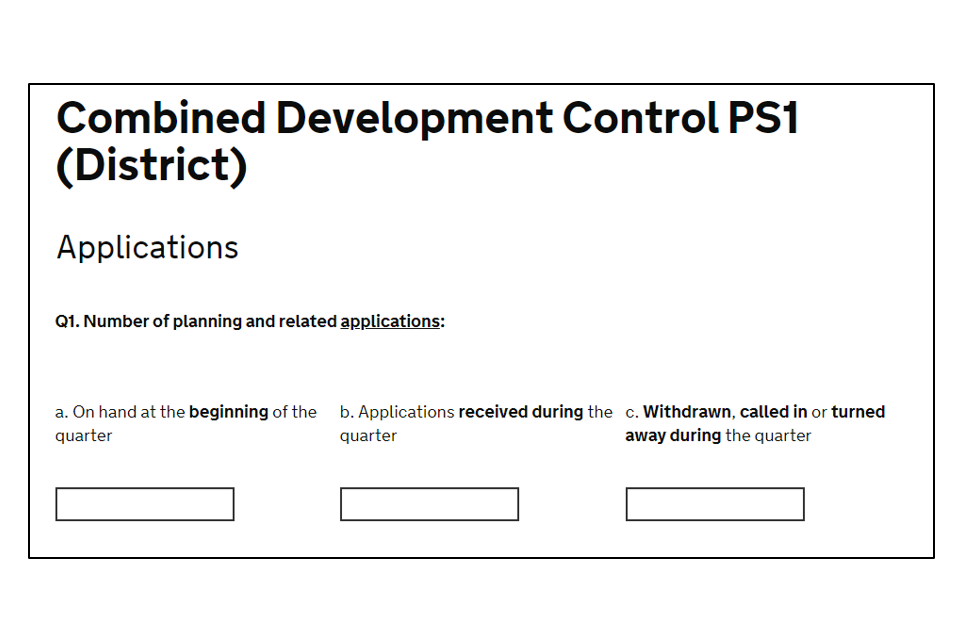
q1
On Question 1c, the following should be included:
(a) Withdrawn applications (an application withdrawn in the current quarter may, of course, be one that was entered in the Register in an earlier quarter). Applications that were initially validated but later found to be incomplete should be included both in the number of applications received and, in the number withdrawn.
(b) Non-determined applications subject to appeal under section 78(2) of the Town and Country Planning Act 1990.
(c) Applications which have not been formally withdrawn but in the opinion of the local authority will never be determined.
(d) Applications called in for determination by the Secretary of State under 77 of the Town and Country Planning Act 1990 or by the Mayor of London under section 2A of that Act; and listed building applications called in for determination by the Secretary of State under sections 12 or 14 of the Planning (Listed Buildings and Conservation Areas) Act 1990 or by the Mayor of London under section 2B of the Town and Country Planning Act 1990.
(e) Applications which the local planning authority has declined to determine (in exercise of the power available to it under sections 70A, 70B or 70C of the Town and Country Planning Act 1990); or under sections 81A or 81B of the Planning (Listed Buildings and Conservation Areas) Act 1990.)
(f) Applications finally disposed of as defined in Article 40 (13) of the Town and Country Planning (Development Management Procedure) (England) Order 2015.
Question 2: Decisions

question2
Note: A decision is made when the decision notice has been despatched to the applicant.
The table below summarises the decisions that to be included within Question 2 and how they relate to other questions on the PS1 form and to the PS2 form.
| Question | To be included within PS1 Q2? | To be included within the PS2 form? |
|---|---|---|
| PS1 Q3 (delegated decisions) | Yes | Yes |
| PS1 Q4 (decisions involving Environmental statements, Planning Performance Agreements or extensions of time) | Yes | Yes |
| PS1 Q5 (Regulation 3 and 4 decisions) | Yes | Yes |
| PS1 Q6 (Prior approval for permitted development rights) | No | No |
| PS1 Q7 (decisions on notifications, certificates of lawful development, certificates of appropriate alternative development and certificates of lawfulness of proposed works to listed buildings) | No | No |
| PS1 Q8 (Enforcement action) | No | No |
The number of decisions recorded under Question 2 should match the total number of decisions recorded (in column A) of the PS2 form.
Question 3: Number of delegated decisions

q3
This question asks you to record how many of the decisions identified in Question 2 were taken by planning officers under delegated powers and without referral to the planning committee. You should exclude those decisions referred for consideration by the committee even if the final decision was taken by an officer. This entry must not be greater than the number of decisions shown in PS1 Question 2a.
Any decisions made using enhanced delegation powers or emergency powers provided through the Local Government Act – e.g. in the light of Coronavirus - should be included.
Question 4

q4
Question 4a asks you to record the number of decisions where a statutory environmental statement was submitted to the local planning authority, as required under the Town and Country Planning (Environmental Impact Assessment) Regulations 2011 (SI 2011/1824).
Please also include environmental statements submitted by a developer in respect of a development which does not fall within either Schedule 1 or Schedule 2, but where the developer has agreed or opted to treat the planning application as if it did fall within the scope of the Environmental Impact Assessment Regulations.
Please exclude any environmental information or documentation submitted as a voluntary adjunct to a planning application and not treated as an environmental statement for the purposes of the Environmental Impact Assessment Regulations.
Question 4b records the number of decisions where the application was subject to a Planning Performance Agreement.
Question 4c records the number of decisions where the application was subject to a written agreed extension of time.
If a decision relates to a renegotiated Planning Performance Agreement, it should be reported at Question 4c, rather than at Question 4b, as a decision for which there was a written agreed extension of time.
The sum of the numbers reported at Questions 4a, 4b and 4c is not expected to equal the number of decisions made during the quarter as reported at Question 2 because it is assumed that many decisions will not have been subject to any type of extension of time.
The above guidance means that a single decision may need to be recorded at more than one of Question 4a, 4b and 4c, such as in the case where a statutory environmental statement has been submitted to the local planning authority for an application that was subject to a Planning Performance Agreement, which would be reported at both Question 4a and Question 4b.
Question 5
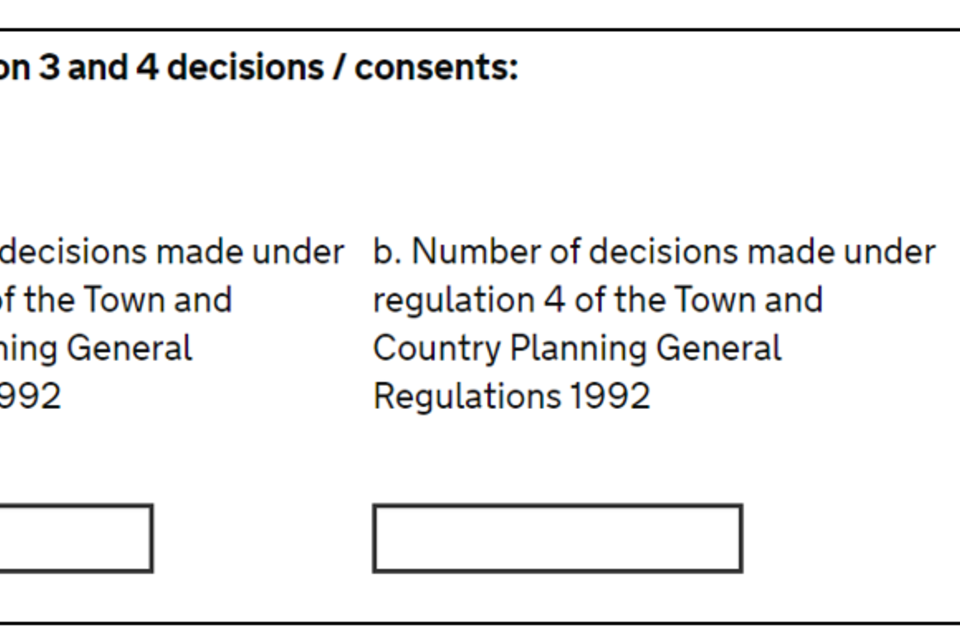
q5
Question 5 asks for information about the number of decisions made under Regulations 3 and 4 of the Town and Country Planning General Regulations. Separate totals are requested for each Regulation. These regulations apply to cases relating to a local planning authority’s own land.
Regulation 3 relates to developments it intends to carry out itself on its own land for the authority’s own purposes, whereas Regulation 4 relates to development for other purposes, such as for commercial activities when the authority doesn’t intend to develop the land itself.
Question 6
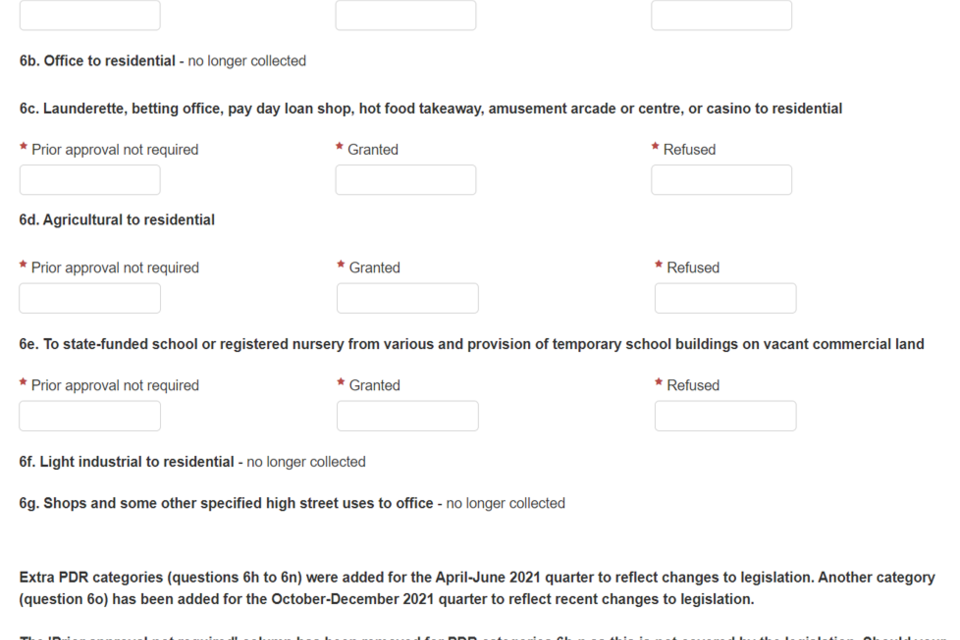
q6 a-g
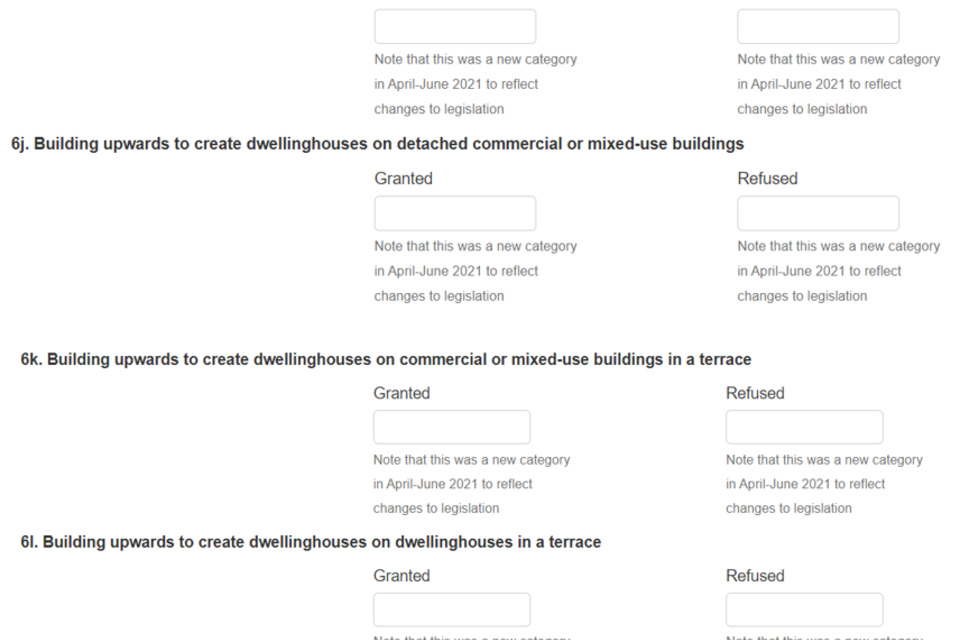
q6 h-m
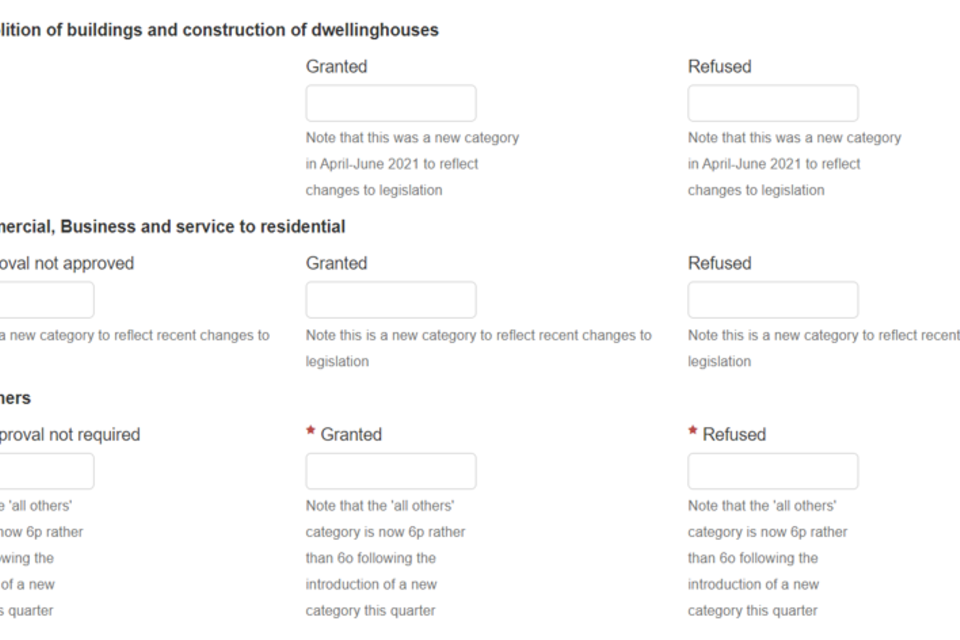
q6 n-p
Question 6 requests a breakdown of decisions on applications for prior approval for permitted development rights and applications for determination relating to permitted development rights during the quarter in relation to permitted development rights under the Town and Country Planning (General Permitted Development) (England) Order 2015.
From the Apr-Jun 2021 quarter, 2 categories 6f & 6g, are no longer collected, and 7 extra categories, 6h to 6n, were introduced to reflect changes to legislation (Part 20 of Schedule 2 to GPDO 2015).
From the October to December 2021 quarter a new category 6o named Commercial, Business and service to residential category (Class MA of Part 3 of Schedule 2 to GPDO 2015) has been introduced. The All Others PDR category has been re-coded as 6p.
The ‘Prior Approval not required’ column for PDR questions 6h-n has now been removed to comply with the legislation though should there be any decisions from the Oct-Dec 2021 quarter these should be included within the ‘Prior approval not required’ column for 6p All Others as well as a mention in the Comment Box. All PDR categories 6h-o are voluntary for completion (All Others is mandatory). If disaggregated data for these specific categories cannot be provided please include any related applications within 6p All Others.
From January to March 2022 quarter category 6b is no longer collected.
The complete list of mutually exclusive categories is as follows:
(a) Larger householder extensions (greater than 4 metres but less than 8 metres for detached dwelling houses, or 3 metres but less than 6 metres for other dwelling houses, as covered by the neighbour notification scheme as set out in paragraph A.4 of the Town and Country Planning (General Permitted Development) (England) Order 2015, Schedule 2, Part 1).
(b) Offices to residential (Town and Country Planning (General Permitted Development) (England) Order 2015, Schedule 2, Part 3, Class O) – no longer collected (from January-March 2022 collection).
(c) Launderette, betting office, pay day loan shop, hot food takeaway, amusement arcade or centre, or casino to residential. Previously named as Retail and sui generis uses to residential[footnote 1] (Town and Country Planning (General Permitted Development) (England) Order 2015, Schedule 2, Part 3, Classes M and N).
(d) Agricultural to residential (Town and Country Planning (General Permitted Development) (England) Order 2015, Schedule 2, Part 3, Class Q).
(e) To state-funded school or registered nursery from various and provision of temporary school buildings on vacant commercial land[footnote 2] (Town and Country Planning (General Permitted Development) (England) Order 2015, Schedule 2, Part 3, Class S; Class T and Part 4, Class CA of Schedule 2).
(f) Light industrial to residential[footnote 3] (Town and Country Planning (General Permitted Development) (England) Order 2015, Schedule 2, Part 3, Class PA) – no longer collected (from April-June 2021 collection).
(g) Shops, financial and professional services, betting office, pay day loan shop, launderette, and hot food takeaway to an office[footnote 4] (Town and Country Planning (General Permitted Development) (England) Order 2015, Schedule 2, Part 3, Class JA) – no longer collected (from April-June 2021 collection).
(h) Building upwards householder extensions[footnote 5] (Class AA of Part 1 of Schedule 2 to the General Permitted Development Order (GPDO 2015).
(i) Building upwards to create dwellinghouses on detached blocks of flats[footnote 5] (Class A of Part 20 of Schedule 2 to GPDO 2015).
(j) Building upwards to create dwellinghouses on detached commercial or mixed-use buildings[footnote 5] (Class AA of Part 20 of Schedule 2 to GPDO 2015).
(k) Building upwards to create dwellinghouses on commercial or mixed-use buildings in a terrace[footnote 5] (Class AB of Part 20 of Schedule 2 to GPDO 2015)
(l) Building upwards to create dwellinghouses on dwellinghouses in a terrace (Class AC of Part 20 of Schedule 2 to GPDO 2015).
(m) Building upwards to create dwellinghouses on detached dwellinghouses[footnote 5] (Class AD of Part 20 of Schedule 2 to GPDO 2015).
(n) Demolition of buildings and construction of dwellinghouses[footnote 5] (Class ZA of Part 20 of Schedule 2 to GPDO 2015).
(o) Commercial, Business and Service to residential[footnote 6] (Class MA of Part 3 of Schedule 2 to GDPO 2015).
(p) All others[footnote 7] – refers to all other types of development for which decisions on applications for prior approval had been made during the quarter. This includes applications for prior approval made under section 73 of the Town and Country Planning Act 1990 to vary or remove conditions. Also include data for the categories at 6h-o here, if disaggregated data for these specific categories cannot be provided at the relevant rows.
For each category, it asks for:
i. The number of prior approval applications where prior approval is not required
ii. The number granted
iii. The number refused
Unless the specific permitted development right is included as an exclusive category within question 6, the application should be recorded under the ‘All others’ category. This includes all those formerly listed under question 6 that are not now listed separately.
In practice, applications where prior approval is not required include:
- Any applications where the local planning authority has provided written notice of their determination that prior approval is not required.
- Any householder applications under Part 1 of Schedule 2, Paragraph A.4 of the Town and Country Planning (General Permitted Development) (England) Order 2015, where no objections have been received by an owner or occupier of any adjoining premises and prior approval is not therefore required.
- Any applications granted implicitly, as a result of the local planning authority taking no action.
Granted applications include:
- Any applications where a local planning authority has made an explicit decision following an objection or following consideration of evidence provided.
- Any applications where the local planning authority has provided a written notice giving their prior approval.
Refused applications include:
- Any applications where the local planning authority consider that the development is not acceptable under the requirements of prior approval and has provided written notice that the prior approval is refused.
- Any applications where the local planning authority consider that the proposed development does not comply with or the developer has provided insufficient information to enable the authority to establish whether the proposed development complies with any conditions, limitations or restrictions of the permitted development and has provided written notice that the prior approval is refused.
Question 7
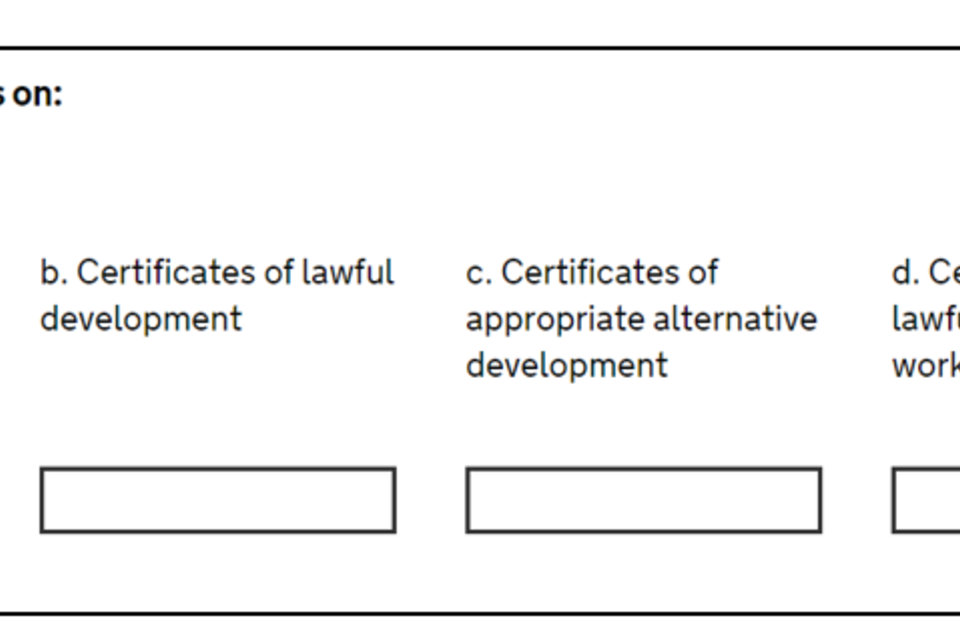
q7
Question 7a – Notifications
Include all decisions relating to notifications under Circular 14/90 (electricity generating stations and overhead lines). The PS1/2 forms no longer record any of the other types of notification that were previously recorded at Q27 on PS2.
For these notifications, the date of decision is the date on which the planning authority sent views/comments to the originating body.
Question 7b - Certificates of lawful development
Please record the number of decisions relating to applications for certificates of lawful development. These include: i) existing uses and developments, and ii) proposed uses and developments
Question 7c – Certificates of appropriate alternative development
Please record the number of decisions relating to applications for certificates of appropriate alternative development. These certificates are an aid to valuation when land is taken by compulsory purchase. They state what planning permissions might have been granted if the scheme underlying the compulsory purchase had been cancelled on the day the notices for the compulsory purchase were issued. The relevant legislative reference is s17 of the Land Compensation Act 1961 (as amended).
Question 7d – Certificates of lawfulness of proposed works to listed buildings
Please record the number of decisions relating to applications for certificates of lawfulness of proposed works to listed buildings.
Question 8: Enforcement Action

question 8
The question asks for the number of enforcement actions across a number of different categories:
(a) The number of enforcement notices issued (under section 172 of the Town and Country Planning Act 1990). Where 2 or more copies of the notice have been served on everyone with an interest in the land, only one notice should be recorded.
(b) The number of stop notices served (under section 183 of the Town and Country Planning Act 1990), excluding temporary stop notices. These should be limited to each particular activity the authority seeks to prohibit. Where several identical notices, prohibiting the same activity on land, are served on a number of people, only one should be recorded.
(c) The number of temporary stop notices served (under section 171E to section 171H of the Town and Country Planning Act 1990). These should be limited to each particular activity the authority seeks to prohibit. Where several identical notices, prohibiting the same activity on land, are served on a number of people, only one should be recorded.
(d) The number of planning contravention notices served (under section 171C of the Town and Country Planning Act 1990). Where the same notice is served on several different people known, or thought, to have an interest in the same land, only one should be recorded. But, where the first notice is served again, later in the investigative process (e.g. because the first notice is ignored or not fully answered) the second or any subsequent notice should be recorded separately.
(e) The number of breach of condition notices served (under section 187A of the Town and Country Planning Act 1990). The number recorded should be limited to one per breach.
(f) The number of enforcement injunctions granted (under section 187B of the Town and Country Planning Act 1990). They do not relate to any injunction sought in the Court under section 222 of the Local Government Act 1972. Please include only injunctions granted by courts, not any which the authority may have sought under its own powers. For each breach only the first decision by the Court should be recorded. For a series of interlocutory injunctions to restrain the same breach of control, only the first should be recorded, even if the injunction is finally refused. If separate injunctions to restrain the same breach are simultaneously granted, only one injunction should be recorded.
(g) The number of injunctive applications refused (under section 187B of the Town and Country Planning Act 1990). They do not relate to any injunction sought in the Court under section 222 of the Local Government Act 1972. Please include only injunctions refused by courts, not any which the authority may have sought under its own powers. For each breach only the first decision by the court should be recorded.
PS2
The PS2 form records more detail on the total number of decisions recorded in PS1 Q2.
The information gathered on this form is used, among other things, to calculate local authorities’ performance for the purposes of designating under-performing authorities under section 62A of the Town and Country Planning Act 1990.
The decisions to be included (and those to be excluded) are defined in the notes for PS1 Questions 1 and 2.
On the PS2 form, the application for a variation or removal of condition should be coded under the same code as the original application (i.e. if original application was for a minor development, the application for a removal of condition should also be classified as a minor development).
The PS2 form is divided between 3 main headers. The first of all counts the Total Number of Decisions, the second the Time Taken From Application To Decision For Applications Not Subject To Planning Performance Agreements, Extensions To Time Or Environmental Impact Assessments, and the final the Applications Subject To Planning Performance Agreements, Extensions To Time Or Environmental Impact Assessments.
Each header is then split between the development categorisations: Major excluding Public Service Infrastructure, Major Public Service Infrastructure, Minor and Other Developments, each with its own sub-categories, followed by a sub-category to record All the PiP and TDC developments included in the (Major, Minor and Other Developments categories for the relevant section) rows above. See section in the appendix titled ‘Permission in Principle and Technical Details Consent applications and decisions’ for further information on how to record PiP and TDC applications.
The screenshots below only cover some of the Major Developments questions – there are additional questions, and users are expected to answer them all.
There are also a number of different final classification options for each header, depending on their specific designation. The ‘Column Total’ figures at the top of each section should auto-update to provide you with a grand total, which you can use to cross-reference figures for accuracy.
Total number of decisions

total number of decisions
This section asks you to record the total number of decisions made in the quarter. A decision is regarded as made when the decision notice has been despatched. The total for decisions entered on PS2 should equal the number of decisions entered in Question 2 of the PS1 section of this form, as well as the total of the 2 following sections.
There is a Question 7 for any Major public service infrastructure development decisions made by a local planning authority during the current quarter.

major public service infrastructure developments
You will first be required to provide information on the total number of decisions for Major Developments (excluding Public Service Infrastructure Developments), then Major Public Service Infrastructure Developments, Minor Developments, then Other Developments, covering each sub-category. For each sub-category, you will be required to provide both the Total, Granted, and Refused decision numbers (previously labelled columns A through C). You will then be asked to record All the PiP and TDC developments included in the (Major, Minor and Other Developments categories for the relevant section) rows above.
See section in the appendix titled ‘Permission in Principle and Technical Details Consent applications and decisions’ for further information on how to record PiP and TDC applications.
Note: The question numbers (e.g. ‘Q1’) follow between different sub-categories with large jumps (such as from Q6 to Q13). This is due to a previous change in the form and requires no action or changes for ongoing use.
Decisions on applications not subject to performance agreements, by time taken
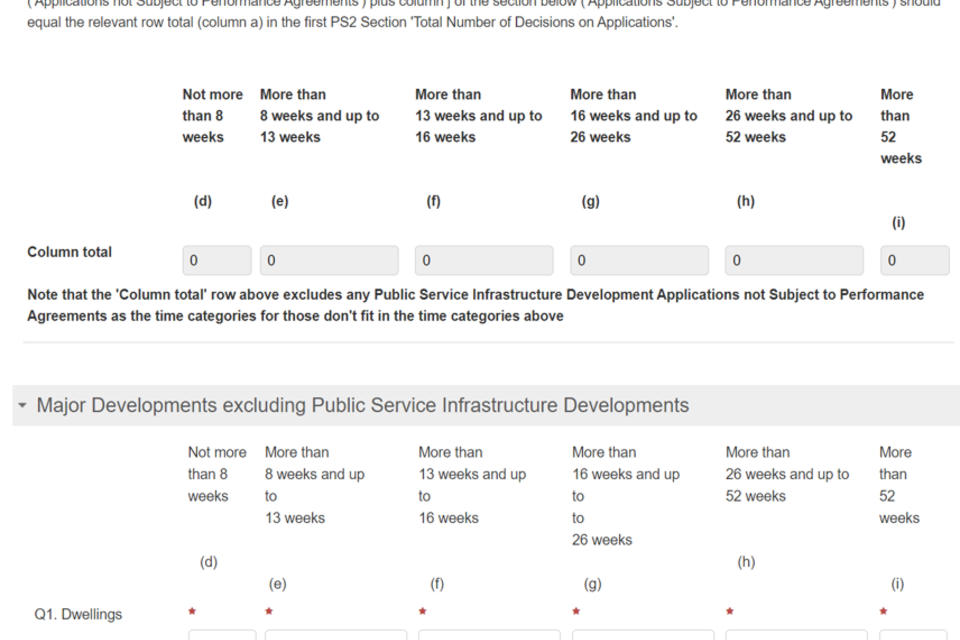
decisions on applications not subject to performance agreements
This section asks you to record the length of time taken for certain decisions to be made (those not subject to the relevant agreements, extensions or assessments). Records are again divided into Major (excluding Public Service Infrastructure), Major Public Service Infrastructure, Minor and Other Development sub-categories and the PiP and TDC developments included in these, with their own classifications for each section.
There are different time taken categories for the new Q7 Major Public Service Infrastructure Development question which do not feed into the Column total line for the standard time taken categories listed above.
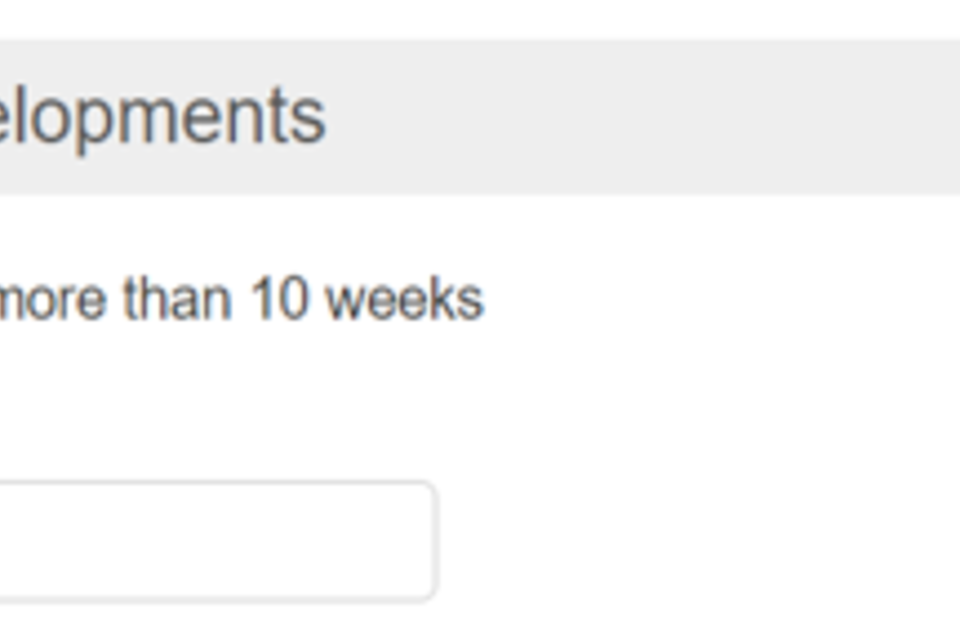
major public service infrastructure developments 2
Applications subject to Performance Agreements are defined as follows:
-
Planning Performance Agreement: a project management tool which sets timescales for actions between the local planning authority and an applicant and which covers pre-application and application stages.
-
Extension of time agreements: under article 34 of the Town and Country Planning (Development Management Procedure) (England) Order 2015 the local authority and applicant can agree to extend in writing the period for determining the application.
-
Environmental Impact Assessment: see the Town and Country Planning (Environmental Impact Assessment) Regulations 2011 (SI 2011/1824).
Where an application for an Environmental Impact Assessment is also subject to a Planning Performance Agreement or agreed extension of time, it should be recorded only once.
The time from application to decision begins when a valid application and the correct fee (if a fee is payable) have been received and ends on the date a decision notice is despatched.
When calculating the time taken to make a decision, on no account should the clock be stopped. Any time spent in abeyance - for example, pending the signing of a section 106 agreement - should be included in the total time taken. The processing period must not be suspended awaiting the receipt of amended plans nor restarted upon receipt of amended plans. It is vital that authorities comply with these instructions to ensure that statistics are produced on a consistent and comparable basis.
Decisions on applications subject to planning performance agreements, by time taken

decisions on applications subject to planning performance agreements
This final section looks for information about those decisions which were not included in the previous section, again regarding timing, but in less detail. Again, following the structure of Major (excluding Public Service Infrastructure), Major Public Service Infrastructure, Minor and Other Developments, PiP and TDC applications, with associated sub-classifications for each subsection. It looks for both the Total decisions count (of applications subject to performance agreements), and the number of Decisions made within 16 weeks (EIA) or the agreed time limit.
For the Line Q7 Major Public Service Infrastructure developments this is similar.

major public service infrastructure developments 3
This section uses the same definitions as the preceding section (see above).
Signing off the return
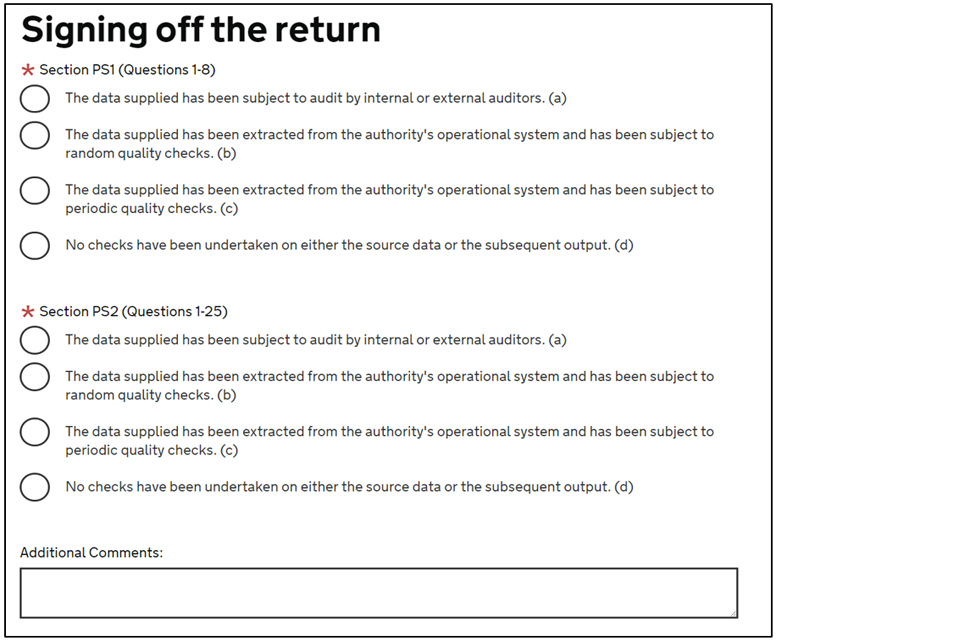
signing off the return
The final Signing off the return sections asks users to verify the data being submitted and indicate the level of quality assurance undertaken. It is important to select the right box below so that you and the department are clear about the accuracy of the data submitted.
An Additional Comments section is also included for further detail to be provided that is not possible to provide in the other sections of the form. You should use this box to explain data entries detailed in any non-mandatory errors (where the data do not need to be changed to clear them), or if there were any issues with the data that DLUHC should be aware of. If present these will be listed in the status report.
Viewing, saving and submitting

view save submit
The final part of the form offers 3 options – ‘PDF’, ‘Save’, ‘Submit’ – with each performing different functions.
Submitting data
Selecting Submit submits the finalised data to DELTA. Users should receive a confirmation email once submission is confirmed and a message will appear at the bottom of the screen, as below. If the submission contains any entry errors, these will be flagged, and users will need to address each before submission can be confirmed. Please be aware that it may take several seconds for submission to be confirmed.
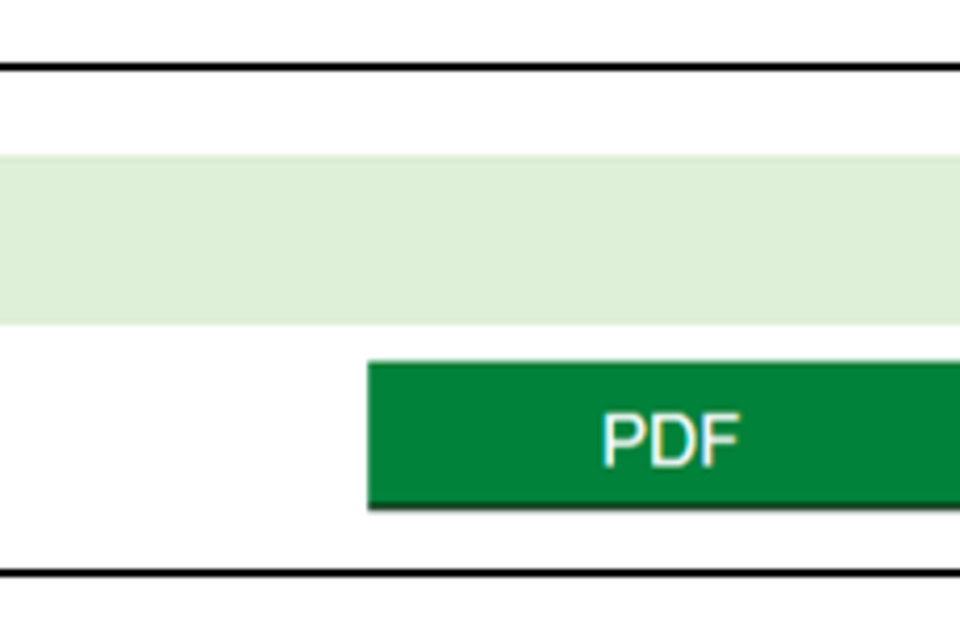
saved
Once submission has been confirmed, users are taken to their Data Store, where they can view all the data submitted. To submit data for a different site, users will need to navigate back to the Collection Requests by clicking on the navigation bar at the top of the page, as above, and selecting the same form again to enter more data.
Viewing and saving
Selecting PDF takes users to a separate window within their web browser which allows them to view their entry and print or save it to their desktop.
Selecting Save allows users to save their entry in the personal Data Store. This can be reviewed and submitted at a later date. To access the Data Store, users will need to either select ‘Submissions’ and then ‘Data Store’ after logging in, or they can access from the navigation bar at the top of the page.

delta
Reminder
Users must Submit their forms once completed, for data to be sent to DLUHC. Clicking Save will maintain the data for users to complete entry at a later point.
Glossary
The Plain English guide to the planning system explains how the planning system in England works. In particular, the flow chart in Annex C on page 20 shows the stages in the planning application process.
Information on the definitions most relevant to the forms are given below, in alphabetical order.
Advertisements
These are decisions on applications for consent to display advertisements under the Town and Country Planning (Control of Advertisements) Regulations 1992 (as amended).
Applications received
The following applications are included:
(a) Valid applications for planning permission for development under Articles 5,6 and 7 of the Town and Country Planning (Development Management Procedure) (England) Order 2015 (SI 2015/595) (as amended) namely:
(i) Applications for outline planning permission
(ii) Applications for approval of reserved matters
(iii) Applications for full planning permission
This includes any application for time limited permission and any application that is accompanied by an environmental statement.
(b) Applications under section 73 of the Town and Country Planning Act 1990 to vary or remove conditions (including applications for minor material amendments).
(c) Developments which would normally have been permitted under the Town and Country Planning (General Permitted Development) Order 1995 but have come before the local planning authority for determination because they require an Environmental Impact Assessment.
(d) Valid applications for listed building consent under section 8 of the Planning (Listed Buildings and Conservation Areas) Act 1990.
(e) Valid applications for planning permission for relevant demolition of an unlisted building in a conservation area under section 70 of the Town and Country Planning Act 1990.
(f) Valid applications for consent to display advertisements under the Town and Country Planning (Control of Advertisements) (England) Regulations 2007 (SI 2007/783) (as amended).
(g) Valid applications under regulations 3 and 4 of the Town and Country Planning General Regulations 1992 (SI 1992/1492) (as amended).
Change of use
Many developments involve some change of land use, but a decision is classified as ‘Change of Use’ only if:
(i) the application does not concern a major development; and
(ii) (a) no building or engineering work is involved; or
(ii) (b) the building or engineering work would be permitted development were it not for the fact that the development involved a change of use
Enforcement activity
Local planning authorities have discretionary powers to take formal enforcement action if, in their view, an unacceptable breach of planning control has occurred. Where it is necessary to stop a breach immediately, the authority may issue a Temporary Stop Notice. This will halt development for 28 days while the alleged breach is investigated and further enforcement action is considered, without the need for the authority to issue an associated enforcement notice.
The authority may issue an Enforcement Notice requiring the alleged breach to be remedied. If an authority considers that any activity alleged in an Enforcement Notice should cease before the end of the specified compliance period, they may serve a Stop Notice prohibiting continuation of that activity. Where conditional planning permission has been granted for a development of land and there has been a failure to comply with one or more of the conditions, an authority may serve a Breach of Condition Notice on any person who is carrying out or has carried out development, or anyone having control of the land, requiring compliance with the conditions specified in the notice.
Householder developments
Householder developments (as referred to in some of the live tables, such as P123) are defined as those within the curtilage of a dwelling house which require an application for planning permission and are not a change of use.
-
Included in householder developments are extensions, conservatories, loft conversions, dormer windows, alterations, garages, car ports or outbuildings, swimming pools, walls, fences, domestic vehicular accesses including footway crossovers, porches and satellite dishes. Granny annexes have been included with effect from 1 July 2014, having previously been recorded under dwellings.
-
Excluded from householder developments are: applications relating to any work to 1 or more flats, applications to change the number of dwellings (flat conversions, building a separate house in the garden), changes of use to part or all of the property to non-residential (including business) uses, or anything outside the garden of the property (including stables if in a separate paddock).
By definition, householder developments that do not require an application for planning permission are also excluded – e.g. for extensions, these include those for which permitted development rights exist, including larger householder extensions (as defined under ‘Permitted development rights’) for which local authority prior approval is needed, and those that satisfy other conditions within the General Permitted Development Order, for which prior approval is not needed, and for which data are therefore not collected.
Listed building consents
Decisions by the district planning authority on:
- (i) applications for listed building consent to extend and/or alter under section 8 of the Planning (Listed Buildings and Conservation Areas) Act 1990; and
- (ii) applications for listed building consent to demolish under section 8 of the Planning (Listed Buildings and Conservation Areas) Act 1990
Major & Minor Developments
Definition (and wider explanation on usage) provided in Appendix below.
Permission in Principle decisions
Details provided in the ‘Useful information’ section of these notes, above: reference to legislation provided in Appendix below.
Permitted development rights
Planning permission for some types of development has been granted nationally through the Town and Country Planning (General Permitted Development) (England) Order 2015. In some cases, if the legislation is complied with, developments can go ahead without the requirement to notify the local planning authority and hence no way of capturing data exists. In other cases, the General Permitted Development Order requires an application to the local planning authority to determine whether prior approval is required, and figures for 14 such categories are collected for district matters:
- Larger householder extensions (greater than 4 metres but less than 8 metres for detached dwelling houses, or 3 metres but less than 6 metres for other dwelling houses, as covered by the neighbour notification scheme as set out in paragraph A.4 of the Town and Country Planning (General Permitted Development) (England) Order 2015, Schedule 2, Part 1).
- Offices to residential (Town and Country Planning (General Permitted Development) (England) Order 2015, Schedule 2, Part 3, Class O).
- Launderette, betting office, pay day loan shop, hot food takeaway, amusement arcade or centre, or casino to residential. Previously named as Retail and sui generis uses to residential (Town and Country Planning (General Permitted Development) (England) Order 2015, Schedule 2, Part 3, Classes M and N).
- Agricultural to residential (Town and Country Planning (Town and Country Planning (General Permitted Development) (England) Order 2015, Schedule 2, Part 3, Class Q).
- To state-funded school or registered nursery from various and provision of temporary school buildings on vacant commercial land (Town and Country Planning (General Permitted Development) (England) Order 2015, Schedule 2, Part 3, Class S; Class T and Part 4, Class CA of Schedule 2).
- Building upwards householder extensions (Class AA of Part 1 of Schedule 2 to the General Permitted Development Order (GPDO 2015).
- Building upwards to create dwellinghouses on detached blocks of flats (Class A of Part 20 of Schedule 2 to GPDO 2015).
- Building upwards to create dwellinghouses on detached commercial or mixed-use buildings5 (Class AA of Part 20 of Schedule 2 to GPDO 2015).
- Building upwards to create dwellinghouses on commercial or mixed-use buildings in a terrace (Class AB of Part 20 of Schedule 2 to GPDO 2015).
- Building upwards to create dwellinghouses on dwellinghouses in a terrace (Class AC of Part 20 of Schedule 2 to GPDO 2015).
- Building upwards to create dwellinghouses on detached dwellinghouses (Class AD of Part 20 of Schedule 2 to GPDO 2015).
- Demolition of buildings and construction of dwellinghouses (Class ZA of Part 20 of Schedule 2 to GPDO 2015).
- Commercial, Business and Service to residential (Class MA of Part 3 of Schedule 2 to GDPO 2015).
- All others - refers to all other types of development for which decisions on applications for prior approval had been made during the quarter (also include data for the categories at 6h-o here, if disaggregated data for these specific categories cannot be provided at the relevant rows).
Prior approvals for permitted developments
Prior approval means that a developer has to seek approval from the local planning authority that specified elements of the development are acceptable before work can proceed. The matters for prior approval vary depending on the type of development and these are set out in full in the relevant parts in Schedule 2 to the General Permitted Development Order. A local planning authority cannot consider any other matters when determining a prior approval application.
Sui generis uses
This is the term used for uses that do not fall into any planning use class. According to the Planning Portal such uses include: betting offices/shops, pay day loan shops, theatres, larger houses in multiple occupation, hostels providing no significant element of care, scrap yards, petrol filling stations and shops selling and/or displaying motor vehicles, retail warehouse clubs, nightclubs, launderettes, taxi businesses, amusement centres, casinos, cinemas, concert halls, bingo halls and dance halls.
Technical Details Consent
Details provided in the ‘Useful information’ section of these notes, above: reference to legislation provided in Appendix below.
Appendix
Major and minor developments: how to classify developments for PS2
Decisions relating to major or minor developments should be classified by reference to the principal use within the development, i.e. the use on which the other uses are considered to depend. Normally this will be the one which accounts for the greater proportion of the new floor space (although in certain cases the principal use will be the one that does not account for any floor space as such).
If there is any doubt as to the principal use in a multi-storey block the ground floor use should be taken as the principal one. (This rule would apply where, for example, the amounts of floor space taken up by 2 different uses were approximately equal). A proposed development should be classified on the basis of its own principal use and not that of the complex of which it is part. This means that a development involving the construction of offices within the curtilage of a general industrial site should be classified as Offices/ Research and Development/Light Industry. Similarly, a dance-floor extension to a restaurant should be classified as ‘All other minor developments’ and not as ‘Retail, distribution and servicing’.
Certain very small developments cannot be said to have any separate use of their own (e.g. the erection of boundary fences, alterations to shop fronts, alterations to vehicular accesses). These developments should be given the same use category as the property concerned.
A decision should be classified as relating to a major/minor development on the basis of the development covered by the application which was decided. Thus the granting of outline permission for the development of a site may have been classified as a major development, but the approval of reserved matters for, say, 5 houses on part of the site would be classified as minor development.
Site area is defined as the area to which the application relates. This should be shown edged in red on plans accompanying an application, while other land in the same ownership but not being developed should be outlined in blue.
If a proposal is for carrying out alteration or works to the same type of existing structure in many locations across a wide area, the local planning authority may accept plans where the area is enclosed by a blue (or, if not owned by the applicant, other coloured) line, and each small works site within that line is ringed or marked out in red. The area in such a case would be the total of all the pieces of land within red lines.
Floor space is taken to be the gross amount (all storeys, including basements and garaging) to be created by the development shown in the application. This is an external measurement, including the thickness of external and internal walls. The local planning authority decides which spaces within a building count for fee assessment purposes.
Major developments - definition
For district matter applications, ‘major development’ means development involving any one or more of the following:
- The provision of dwelling/houses where –
- The number of dwelling/houses to be provided is 10 or more: or
- The development is to be carried out on a site having an area of 0.5 hectares or more and it is not known whether the number of dwelling/houses to be provided is 10 or more.
- The provision of a building or buildings where the floor space to be created by the development is 1000 square metres or more: or
- Development carried out on a site having an area of 1 hectare or more;
Where a site above 1 hectare is subject to a change of use application, it should be coded under major development and not as a change of use (Question 20). Any other applications for change of use should be captured under Question 20 and not under the relevant major/minor development category.
Minor developments - definition
For dwelling/houses, minor development is one where the number of dwelling/houses to be provided is between 1 and 9 inclusive on a site having an area of less than 1 hectare. Where the number of dwelling/houses to be provided is not known, a site area of less than 0.5 hectares should be used as the definition of a minor development. For all other uses, a minor development is one where the floor space to be created is less than 1,000 square metres or where the site area is less than 1 hectare.
Please note that for each of rows Q1 to Q6, Q13 to Q18 and Q20 to Q25, the sum of the entries in columns D to I and J must equal the entry in column A.
Sub-category definitions
The rows containing questions Q7 to Q12 were removed with effect from April 2014, following the decision that separate rows were no longer needed for large-scale and small-scale major developments. The references below reflect the changes to use classes that took effect from 1 September 2020 under the Town and Country Planning (Use Classes) (Amendment) (England) Regulations 2020, which have had no effect upon the definition of any sub-category.
Q1 (major) and Q13 (minor) – Dwellings
Please record any applications for development in use class C3 (dwelling houses) in Town and Country Planning (Use Classes) Order 1987 (SI 1987/764) (as amended) under the relevant question according to the size of the application.
Please exclude residential uses that fall in other use classes e.g. hotels (C1), residential institutions such as hospitals and nursing homes, houses in multiple occupation (C4 or Sui Generis) and caravan sites.
Although the guidance notes for April to June 2014 and previous quarters have asked for granny annexes to be included under Q1 or Q13 as appropriate, the department has reviewed this part of the guidance and concluded that granny annexes should now be recorded at question Q21 (householder developments).
Q2 (major) and Q14 (minor) – Offices, R&D, and light industry
Please record any relevant applications for development in use classes E in Town and Country Planning (Use Classes) Order 1987 (as amended) (e.g. financial and professional services and businesses) (under the relevant question according to the size of the application.
Examples of applications that should be recorded here include banks, building societies, estate agents, general offices and those for research and non-polluting industrial processes.
Q3 (major) and Q15 (minor) – General Industry, storage and warehousing
Please record any applications for development in use classes B2 (general industrial) and B8 (storage or distribution) in Town and Country Planning (Use Classes) Order 1987 (as amended) under the relevant question according to the size of the application.
Q4 (major) and Q16 (minor) – Retail and services
Please record any relevant applications for development in use classes E in Town and Country Planning (Use Classes) Order 1987 (as amended) (e.g. shops, restaurants and cafes) or which are sui generis (drinking establishments and hot food takeaways only) under the relevant question according to the size of the application.
Q5 (major) and Q17 (minor) – Traveller caravan pitches
Decisions on applications in relation to Traveller caravan sites should be recorded in the relevant category of development of major or minor development. There is a requirement to separately record these types of applications in order to help monitor the effectiveness of the department’s Planning Policy for Traveller Sites. Although applications may refer to ‘sites’, please record the number of pitches the local authority believes the site would provide. An application determined for between 1 - 9 pitches should be recorded as a minor development, and 10 or more pitches as a major development.
Q6 (major) and Q18 (minor) – All other developments
Please record any decisions on applications other than those already captured in Questions 1 to 5 and 13 to 17 according to the size of the application.
This includes developments in the following use classes:
- C1 (hotels)
- C2 (residential institutions)
- C4 (houses in multiple occupations for 3 to 6 residents)
- E (gymnasiums, indoor recreations not involving motorised vehicles or firearms)
- F1 (non-residential institutions)
- Sui generis uses except drinking establishments and hot food takeaways): Certain uses do not fall within any use class and are considered ‘sui generis’. Such uses include: betting offices/shops, payday loan shops, theatres, houses in multiple occupation for more than 6 residents, hostels providing no significant element of care, scrap yards, petrol filling stations and shops selling and/or displaying motor vehicles, retail warehouse clubs, nightclubs, launderettes, taxi businesses, amusement centres, casinos, cinemas, concert halls, bingo halls and dance halls[footnote 8].
Q7 – Major Public Service infrastructure developments
For more details on Major Public Service Infrastructure developments please refer to pages 5-6 of the July 2021 Planning Newsletter (PDF, 249KB).
Other developments
The former Question 19 (minerals processing) was removed from the form with effect from April 2014.
Q20 - Change of use
Many developments involve some change of land use but a decision should be recorded under Q20 as a ‘Change of Use’ only if the application does not have a site area greater than 1 hectare; and
(a) No building or engineering work is involved; or>br> (b) The building or engineering work would be permitted development were it not for the fact that the development involved a change of use.
Q21 - Householder developments
Householder developments are defined as those within the curtilage of a dwelling house which require an application for planning permission and are not a change of use.
The following should be included under this question: extensions, conservatories, loft conversions, dormer windows, alterations, garages, car ports or outbuildings, swimming pools, walls, fences, domestic vehicular accesses including footway crossovers, granny annexes, porches and satellite dishes.
As stated under the guidance for ‘Q1 (major) and Q13 (minor) – Dwellings’ above, although the guidance notes for April to June 2014 and previous quarters have asked for granny annexes to be included under Q1 or Q13 as appropriate, the department has recently reviewed this part of the guidance and concluded that granny annexes should now be recorded at Q21, as listed above.
The following should be excluded under this question: applications relating to any work to 1 or more flats, applications to change the number of dwellings (flat conversions, building a separate house in the garden), changes of use to part or all of the property to non-residential (including business) uses, anything outside the garden of the property (including stables if in a separate paddock).
Applications for prior approval for permitted development rights for larger householder extensions are included in Q6 on PS1.
Q22 – Advertisements
Please record any decisions on applications for consent to display advertisements under the Town and Country Planning (Control of Advertisements) (England) Regulations 2007 (as amended).
Where a split decision is issued in the case of advert consents, these should be recorded as granted.
Q23 - Listed building consents to alter/extend
Please record any decisions on applications for listed building consent to extend and / or alter under Section 8 of the Planning (Listed Buildings and Conservation Areas) Act 1990.
Please exclude any decisions made by the Secretary of State, such as on applications made under regulation 13 of the Planning (Listed Buildings and Conservation Areas) Regulations 1990 relating to a local planning authority’s own application for listed building consent.
Q24 - Listed building consents to demolish
Please record any decisions on applications for listed building consent to demolish under Section 8 of the Planning (Listed Buildings and Conservation Areas) Act 1990.
Q25 - Relevant demolition in a conservation area
Please record any decisions on planning applications for relevant demolition of an unlisted building in a conservation area under section 70 of the Town and Country Planning Act 1990.
Q26 to Q29 are deliberately not allocated, given that some local planning authorities are known to use at least some of these questions for their own categories within their own systems.
Q30 - Total number of Permission in Principle (minor housing-led development) decisions
Please record the number of Permission in Principle decisions on minor housing-led developments made during the quarter made under the Town and Country Planning (Permission in Principle) Order 2017 (as amended), and as recorded under the relevant development type(s) elsewhere on this PS2 return.
Q31 - Total number of Technical Details Consent (minor housing-led development) decisions
Please record the number of Technical Details Consent decisions on minor housing-led developments made during the quarter made under the Town and Country Planning (Permission in Principle) Order 2017 (as amended), and as recorded under the relevant development type(s) elsewhere on this PS2 return.
Q32 - Total number of Technical Details Consent (major development) decisions
Please record the number of Technical Details Consent decisions on major developments made during the quarter made under the Town and Country Planning (Permission in Principle) Order 2017 (as amended), and as recorded under the relevant development type(s) elsewhere on this PS2 return.
Permission in Principle and Technical Details Consent applications and decisions
Since 16 April 2017, local planning authorities have had the ability to grant permission in principle (PiP) to sites which have been entered on their brownfield land registers. Where sites have a grant of permission in principle, applicants have been able to submit an application for Technical Details Consent (TDC) for development on these sites. In addition, since 1 June 2018, it has also been possible to make an application for PiP for minor housing-led development as a separate application, independently of the brownfield register. Where a site has been granted PiP following an application, it is possible to apply for a TDC and a determination period of 5 weeks applies as it is minor development. Extensions of time may be agreed.
TDC applications have a 10-week determination period for major development and a 5-week determination period for minor development. Extensions of time may be agreed and where it is an Environmental Impact Assessment (EIA) development, the 16-week determination period applies.
Any TDC or PiP applications received or decisions made during the quarter should be included under Questions 1 to 4 of the PS1 as relevant, and within the relevant development type (i.e. row) within Questions 1 to 25 of the PS2. They should also be included in the relevant columns of these rows, even though the columns collecting information on the time taken don’t directly reflect the TDC or PiP deadlines.
For example, all TDC decisions made within 8 weeks should be included within the ‘Not more than 8 weeks’ column, whether they were applications for minor development made within the 5 weeks statutory period for TDC applications for minor developments, or later than that. Similarly, all PiP decisions made within 8 weeks should be included within the ‘Not more than 8 weeks’ column, whether they were made within the 5 weeks statutory period for PiP applications, or later than that.
This should not be taken as implying that the department’s expectations on the time taken for making TDC or PiP decisions have been lowered: it simply reflects the columns used in the PS2 return.
In addition, with effect from the January to March 2020 quarter, the PS2 return includes an additional 3 rows at the foot of the 3 sections of the PS2 form (“Total Number of Decisions on Applications”, “Decisions on Applications Not Subject to Performance Agreements” and “Decisions on Applications Subject to Performance Agreements”). These 3 rows capture summary figures of decisions included elsewhere in the PS2 return for the following 3 elements:
- Row 30: Total number of Permission in Principle (minor housing-led development) decisions
- Row 31: Total number of Technical Details Consent (minor housing-led development) decisions; and
- Row 32: Total number of Technical Details Consent (major development) decisions
For each of these 3 rows, the relevant column has been split into 2 to directly reflect the relevant PiP or TDC deadline: e.g., for row 30, column d (usually ‘Not more than 8 weeks’) has been split into d-1 (‘Not more than 5 weeks’) and d-2 (‘More than 5 weeks and up to 8 weeks).
These rows have been included following discussion between central and local government representatives within the Central Local Information Partnership (CLIP) Planning Statistics Sub-Group.
-
The permitted development right for retail and sui generis uses to residential includes hot food takeaway (included in Class M) to residential, following the regulations which came into force in May 2019. This is being collected in PS1 question 6c) with effect from the October to December 2019 quarter until July to September 2021 quarter. Renamed as Launderette, betting office, pay day loan shop, hot food takeaway, amusement arcade or centre, or casino to residential in October to December 2021 quarter. ↩
-
The permitted development right for the provision of temporary school buildings on vacant commercial land was introduced in April 2017 and has been included within PS1 question 6e) with effect from the April to June quarter of 2017. ↩
-
This question previously included changes from storage or distribution centres to residential use, for which the time-limited permitted development right expired on 10 June 2019. Those applications which received prior approval before 10 June 2019 have 3 years in which to change use. The permitted development right for change of use from storage or distribution centres was removed from PS1 question 6f) with effect from the October to December quarter of 2019. ↩
-
The permitted development right for shops and other specified high street uses to office was introduced on 25 May 2019 and was introduced as a new question in PS1 with effect from the October to December quarter of 2019. ↩
-
The permitted development rights for categories 6h to 6n, reflecting the 7 new dwellinghouses categories (Part 20 of Schedule 2 to GPDO 2015), were introduced as new questions from the April to June quarter of 2021. ↩ ↩2 ↩3 ↩4 ↩5 ↩6
-
The permitted development right for Commercial, Business and service to residential category (Class MA of Part 3 of Schedule 2 to GPDO 2015) was introduced as a new question from the October to December quarter of 2021. ↩
-
The ‘All others’ permitted development rights category was re-coded as 6h) (previously 6g)) following the introduction of the ‘Shops and other specified high street uses to office’ category, with effect from the October to December quarter of 2019. It has since been re-coded as 6o) for the April to June and July to September quarters of 2021 following the introduction of extra Building upwards PDR categories 6h)-6n), and recoded again as 6p following the introduction of the Commercial, Business to Residential category in the October to December 2021 quarter. ↩
-
Definition from the Planning Portal. ↩
